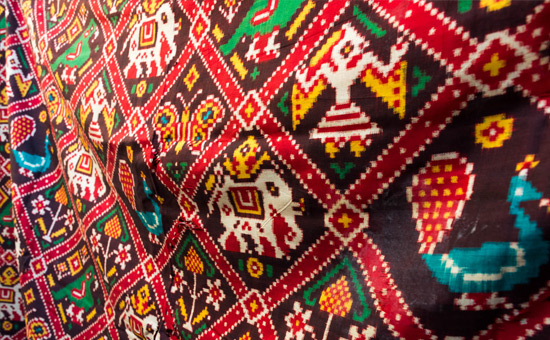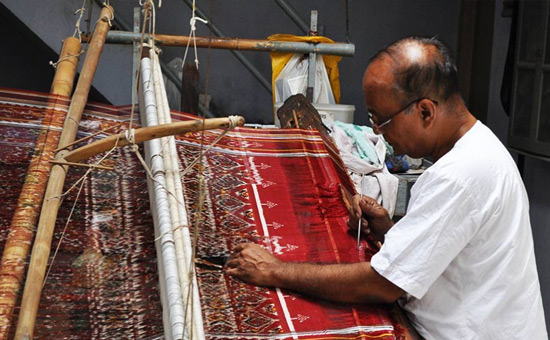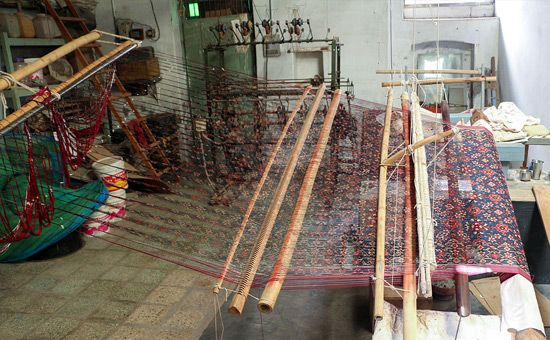- In
19th century England and France, Indian textiles were a big hit.
Take the Jamawar shawls for example. The aristocracy of France were so obsessed
with the Jama shawls that local producers in France started supplying cheap
imitation of the shawls with a ‘Made in India’ tag. This way the clientele were
happy and local producers made hefty sums of money. Such was the beauty and magnificence
of Indian textiles, and it still is.
A famous Gujarati folk song based on Patola is, “Chelaji re, mare hatu Patan thi Patola mongha lavjo,”
meaning: Oh my dear, please bring the precious Patola from Patan for me!
Patan,
the house of Patola, is 125 kms away from Ahmedabad. The town is also famous
for ‘Rani –ki Vav’, a step-well made by a queen in honour of her husband. It is
now a UNESCO World Heritage site.
About 900 years ago in 1143 A.D., around 700 craftsmen from the Salvi community hailing from modern day Karnataka and Maharashtra were brought by king Kumarpal of the Solanki dynasty (who then ruled Gujarat, parts of Rajasthan and Malwa) to his court, in his kingdom’s capital, Patan. These craftsmen lived in Jalna, situated in southern Maharashtra, and were considered to be the finest craftsmen of Patola.
So how did Patola come to Patan?
According
to a narrative, king Kumarpal was extremely fond of Patola and wore it to all
auspicious and formal occasions. Since it was made elsewhere, the king found it inconvenient so he shifted the
craftsmen to his capital. This way the king could have Patola all for himself,
made on demand and customized. Since then, Patola has been produced only in
Patan, Gujarat and has lost its roots from where it originally germinated.
However, another very popular sari making town Paithan is only 76 kms from
Jalna. The Paithanis are quite famous and are still produced by the fine
craftsmen of Paithan. One is not sure whether the Paithanis or Patolas have a
connection or not.
Another narrative is that Patola craftsmen were taken as spoils of war when king Kumarpal defeated and sacked Jalna in the 12th century.
A
third story associated with Patola weaves says that when Kumarpal learned that
his supply of Patolas were used as bed-sheets by Jalna’s king before selling it
to him, the king was furious. And so he picked up 700 craftsmen from Jalna and brought
them to Patan.
Whichever
story is true, the reality is that the charm and majesty of Patola continues to
amaze us even today. During Kumarpal’s reign, Patola became incredibly famous and
thus even after the decline of the Solanki dynasty, Patola found its way into
the royal families and aristocrats of Gujarat. At its zenith, Patola reached
Indonesia, Malaysia and Thailand.
Patola as a sacred heirloom...Patola
isn’t just a piece of cloth, it’s a tradition, and it’s sacred. Here is why.
Firstly,
the craftsmanship of Patola is only passed to the family members belonging to
the same community i.e. the Salvis. A stranger cannot knock the door of a
Patola weaver and ask the weaver to teach him the craft.
Secondly,
Patola acts as an heirloom. Patola saris were given to aristocratic women as a
part of stridhan during their
marriage. They were expected to pass it on to their daughter during her
marriage. Ditto with daughter-in-laws.
In
fact, the designs used in Patola include shikhar
(the square) which denotes security. Elephant, parrot, peacock, kalash (jug) and humans are also used
extensively. All these designs are symbolic of saubhagya or good luck for women.
![]()
![]()
![]()
 Elephant, peacock, parrot, girl & flowers on Patola sari. Credits: www.guidetogo.in
Elephant, peacock, parrot, girl & flowers on Patola sari. Credits: www.guidetogo.in
Patola
textiles were reserved for a certain strata of people. Naturally, due to its
exquisiteness and price, everyone could not afford to buy it. As a result,
Patola saris became a status symbol in the Gujarati society. Patolas were also
gifted to kings and priests in order to forge good relations.
Another
interesting thing about Patola is that earlier it was only worn during
extremely pious and special occasions. King Kumarpal for instance only wore
them while offering prayer, performing important rituals and on religious
ceremonies since he needed to be holy, clean and unmarked on such occasions. This
tradition started by Kumarpal, the biggest proponent of Patola, spread across entire
Gujarat.
Between
15-16 centuries Patola gained prominence in Indonesia too. There, Indonesians
consider wearing Patola as a matter of great pride. They call it the cloth of ma’a or mawa meaning ‘a cloth created by the god’. Because only God can
create something of such beauty and perfection, right?
Patola in modern day India...Patola
is undoubtedly the epitome of fine craftsmanship. Today, only 2-3 families, the
Salvis and Sonis, practise this 900 year old craft in Patan. These families
aren’t very open about the process of forging Patola. Only the family members,
and in some cases only the male family members, are passed down this knowledge.
Nobody from outside the community is admitted into craftsmanship.
However,
in the past few years, the Sonis have loosened their boundaries and started
passing this craft to people outside of their family who are hardworking,
dedicated and passionate towards the craft. This change of attitude is because
of the fear of Patola becoming extinct.
 A weaver giving life to a Patola sari. Credits www.gatha.com
A weaver giving life to a Patola sari. Credits www.gatha.com
The
current state of this art is alarming. Some Patola weavers have predicted that
the art will vanish within the next 20 years or so. Lack of investment, fewer weavers,
and dis-interest on the part of the younger generation of weaving families are reasons
for such a prediction. Also cheap imitations are capturing the market.
It
must be noted that when an art or skill is limited to a community, its fortunes
are tied to the community. Surely the Salvi parivar has grown but everyone
might not want to pursue this profession. If this art has to survive then it
needs to be institutionalised and thrown open to others. Here is an example –
Maheshwar in Madhya Pradesh was a well-known weaving centre for Maheshwari weaves. Due to lack of public awareness and a host of other reasons, demand fell and weavers suffered. It was only when the erstwhile rulers of Maheshwar, Shivaji Rao and his wife Sally Holkar, set up Rehwa Society in around 1980 so that the Maheshwari tradition could come to life again. Today there are about 7,500 looms in Maheshwar making all types of Maheshwari weaves. Surely some make inferior quality products but for a truly interested consumer, Rehwa Society products are the benchmark.
Tip: Patola saris cost Rs 1,00,000/ or above today. So if you are getting a sari for less than that, then it is probably not 100% Patola.
Since Patola saris are expensive, they are predominantly bought by the rich. Having said that, if you know the weaving process and effort that goes into making such saris, you might not complain about the price.
Weaving process, colours, designs and
motifs.... The
first step in the weaving process is to trace sari design on paper. Next, the
silk yarn is tied using cotton threads as per the design or pattern. The warp
(vertical) and weft (horizontal) threads are tied separately. Thereafter the
entire yarn is dyed in the desired colour. This tying, untying, retying and
dying is repeated for each colour. If there are 4 colours in a sari, the process
will be done 4 times to get all the 4 colours. Once the dying part is complete,
the yarn is put on the loom to weave the cloth.
 Final step of weaving the yarn after dying. Credits: www.lostwithpurpose.com
Final step of weaving the yarn after dying. Credits: www.lostwithpurpose.com
The
tying and dying is done in a pattern to get the planned design. Tying these
knots helps form the pattern by exposing only the parts to be dyed in that
colour. For example, if a square is to be coloured blue and the rest of the design
is red then cotton knots will be placed around the square to prevent red colour
from filling into the square while dying and vice versa. This whole process is
called resist
dying. It is highly mathematical and unimaginably difficult. On an
average, it takes one year to make a full-fledged Patola sari.
The
weaving is done on a traditional harness loom made up of rosewood and bamboo
strips. The loom is slightly tilted from one side because of which 2 people are
required to work simultaneously on a loom.
 A traditional Patola loom. Credits: www.utsavpmpedia.com
A traditional Patola loom. Credits: www.utsavpmpedia.com
Patola
is a double Ikat weave, meaning there is no reverse side to it. It can be worn
from both the sides. Due to this feature, the colour of Patola doesn’t fade
even after a 100 years of usage, although the fabric might wear out. Ikat is central
to Patola’s design.
Note
that Ikat is also a type of textile produced in modern day Andhra Pradesh and
Telangana. It’s a common name for the yarn, technique and the fabric. Generally
speaking, it is a dyeing technique that involves resist dyeing process.
Colours
Natural
dyes like catechu, cochineal, indigo, turmeric,
natural lakh, harde, madder roots, manjistha,
ratnajyot, katha, kesudo,
pomegranate skin, henna, marigold flower are employed in making Patola. While
Alum, copper sulphate, ferrous sulphate, tin chloride, potassium dichromate and
other mordents are also used.
Designs and Motifs: Typically,
abstract designs and geometric patterns are unfolded on Patola. While some
designs include elephants, human figures, kalash, flowers, shikhar, paan,
parrot etc. other designs are inspired by the heritage architecture of Gujarat.
You can clearly see intricate designs from historical monuments coming alive on
these beautiful saris. Some more designs include Narikunjar, Navratna,Voharagaji
(Manek Chock), Chabbri bath, Chandabhati,
Patan Bhatt, Laheriya, Taraliya, Fulbhatt, KesarChandan etc.
Patola
involves intensive manual work, utmost fortitude and exactitude. Weavers work
day and night to create this masterpiece. Yes, masterpiece! There is no other
way to put it. However, over time and somewhat due to industrialisation and
‘westernization’, people seemed to have forgotten about this masterpiece.
We
can change things by wearing more of hand-woven textiles. Remember that the
handloom industry is a large employer with a significant participation by
women. So when you buy handloom you are not only providing employment to
millions but keeping India’s rich tradition alive. If weavers make sufficient money,
the tradition will surely survive.
Close
to Rani ki Vav and opposite the New Kailka Temple is the Patan Patola Heritage
Museum. It is well worth a visit. To buy a Patola sari, call Kanaiyalal Salvi
at +91-98246 13843, 98250-77562. For more information, you can visit www.patanpatola.com
Cover pic credits - www.utsavpedia.com
May
the prolific art of Patola live forever!
Also see
1 Rani kiVavPatan
step-well
2 Paithani Saris Paithani 76 kms away from Jalna
3 Rehwa Society
and Maheshwar Saris Maheshwar
4 Bhujodi Weavers
Kutch
5 Barmer Rajasthan
textiles known for Applique work
6 IKAL saris
Karnataka
7 Tuskin Saris at
heritage village Raghurajpur near Puri